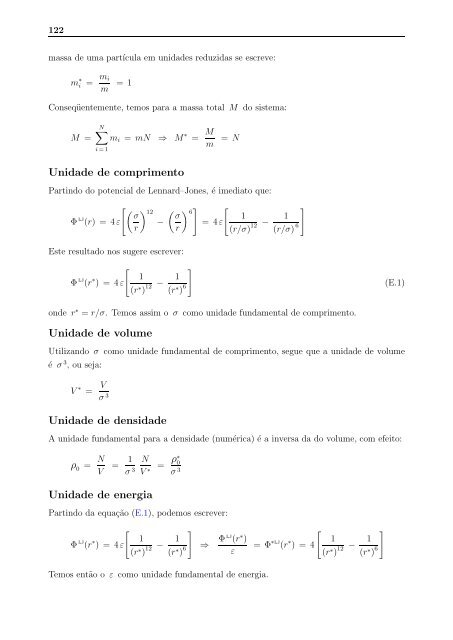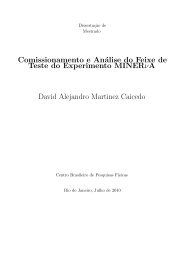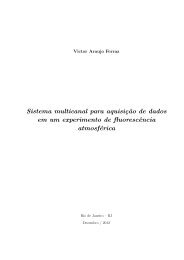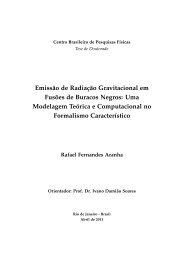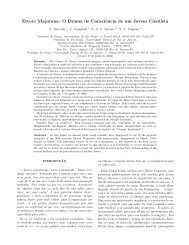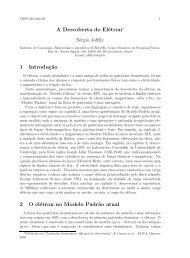Expoente de Lyapunov para um Gás de Lennard–Jones - CBPFIndex
Expoente de Lyapunov para um Gás de Lennard–Jones - CBPFIndex
Expoente de Lyapunov para um Gás de Lennard–Jones - CBPFIndex
Create successful ePaper yourself
Turn your PDF publications into a flip-book with our unique Google optimized e-Paper software.
122<br />
massa <strong>de</strong> <strong>um</strong>a partícula em unida<strong>de</strong>s reduzidas se escreve:<br />
m ∗ i = mi<br />
m<br />
= 1<br />
Conseqüentemente, temos <strong>para</strong> a massa total M do sistema:<br />
M =<br />
N<br />
i =1<br />
mi = mN ⇒ M ∗ = M<br />
m<br />
Unida<strong>de</strong> <strong>de</strong> comprimento<br />
= N<br />
Partindo do potencial <strong>de</strong> <strong>Lennard–Jones</strong>, é imediato que:<br />
Φ lj σ 12 (r) = 4ε −<br />
r<br />
<br />
6<br />
σ<br />
r<br />
Este resultado nos sugere escrever:<br />
Φ lj (r ∗ ) = 4ε<br />
<br />
1<br />
(r∗ 1<br />
12 −<br />
)<br />
(r ∗ ) 6<br />
<br />
= 4ε<br />
<br />
1<br />
(r/σ)<br />
12 −<br />
1<br />
(r/σ) 6<br />
<br />
on<strong>de</strong> r ∗ = r/σ. Temos assim o σ como unida<strong>de</strong> fundamental <strong>de</strong> comprimento.<br />
Unida<strong>de</strong> <strong>de</strong> vol<strong>um</strong>e<br />
(E.1)<br />
Utilizando σ como unida<strong>de</strong> fundamental <strong>de</strong> comprimento, segue que a unida<strong>de</strong> <strong>de</strong> vol<strong>um</strong>e<br />
é σ 3 , ou seja:<br />
V ∗ = V<br />
σ 3<br />
Unida<strong>de</strong> <strong>de</strong> <strong>de</strong>nsida<strong>de</strong><br />
A unida<strong>de</strong> fundamental <strong>para</strong> a <strong>de</strong>nsida<strong>de</strong> (n<strong>um</strong>érica) é a inversa da do vol<strong>um</strong>e, com efeito:<br />
ρ 0 = N<br />
V<br />
= 1<br />
σ 3<br />
Unida<strong>de</strong> <strong>de</strong> energia<br />
N<br />
V ∗ = ρ∗ 0<br />
σ 3<br />
Partindo da equação (E.1), po<strong>de</strong>mos escrever:<br />
Φ lj (r ∗ ) = 4ε<br />
<br />
1<br />
(r∗ 1<br />
12 −<br />
)<br />
(r ∗ ) 6<br />
<br />
⇒ Φlj (r ∗ )<br />
ε<br />
Temos então o ε como unida<strong>de</strong> fundamental <strong>de</strong> energia.<br />
= Φ ∗lj (r ∗ ) = 4<br />
<br />
1<br />
(r∗ 1<br />
12 −<br />
)<br />
(r ∗ ) 6


